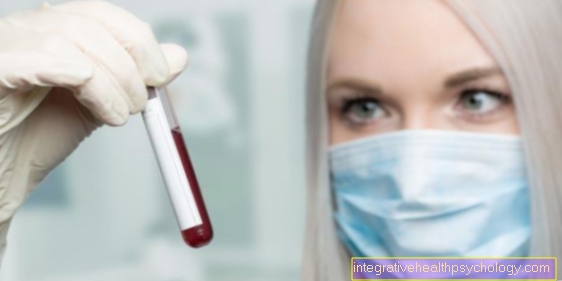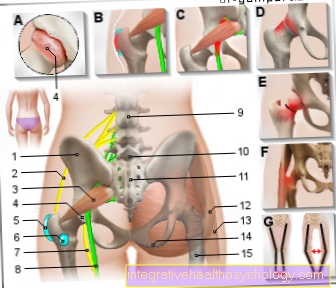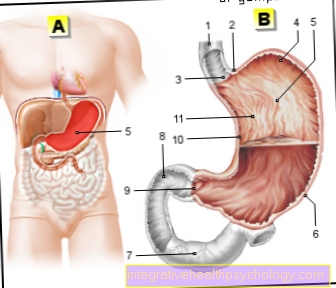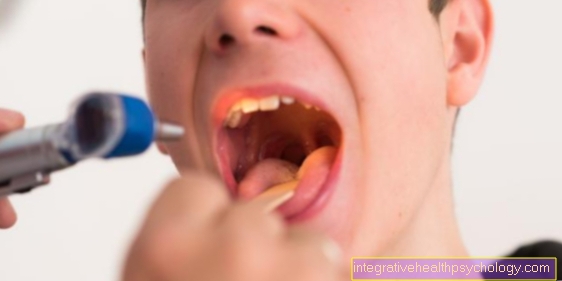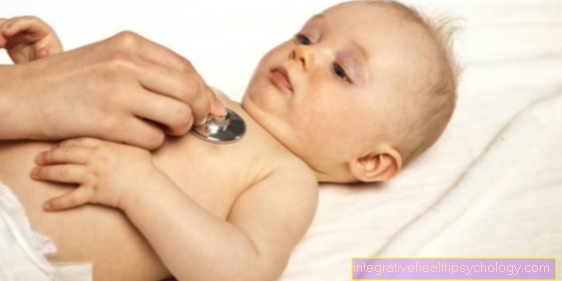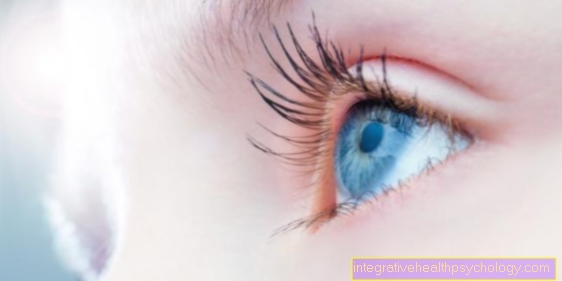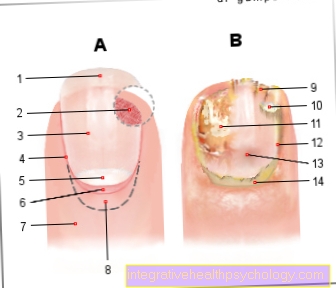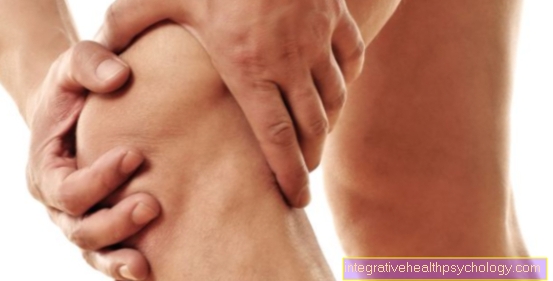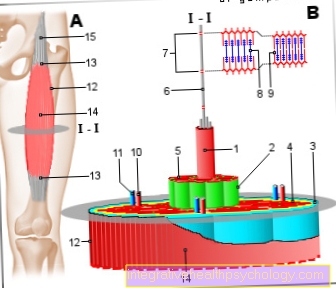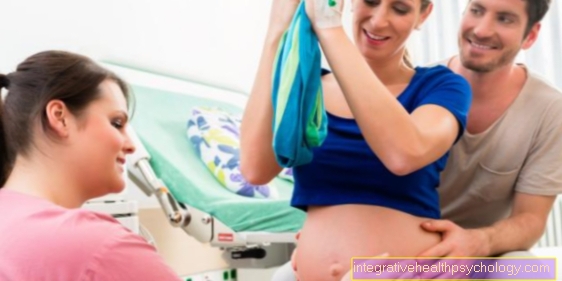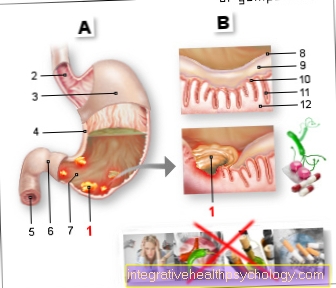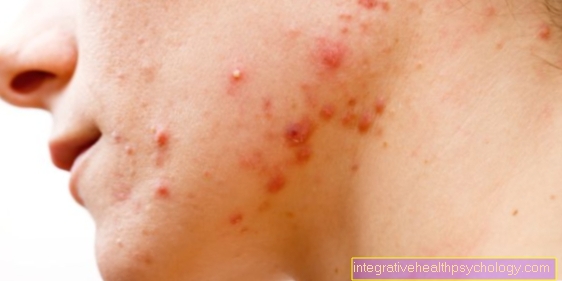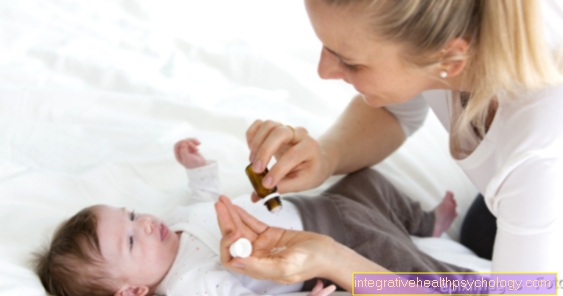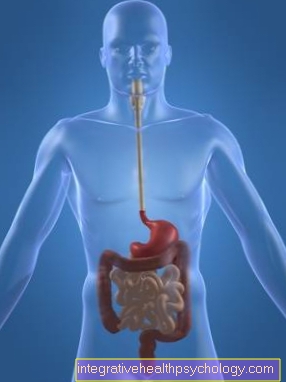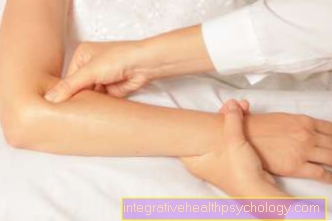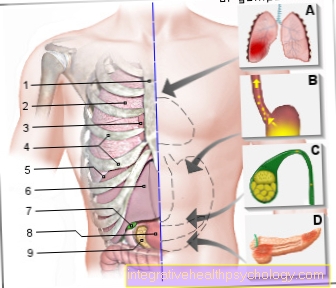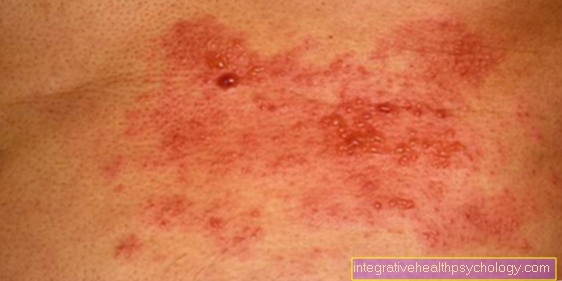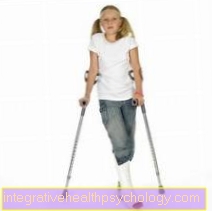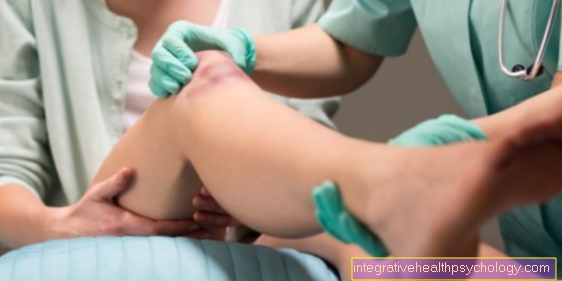Shingles incubation period
What is the incubation period?
The doctor understands the incubation period as time, between the Contact with a pathogen and the first symptoms of the disease.

The incubation period of shingles
The disease of shingles is always a reactivation of the virus (flare-up of an infection), which remain in the nerves (persist).
The viruses are transmitted to a person when they first become infected, causing the childhood disease “chickenpox”. In this case, an incubation period of 14 to 16 days is specified. This means that about 2 weeks after contact with the infectious virus, the first symptoms of chickenpox become noticeable.
After the chickenpox has healed, the viruses remain in the nerve cells of the previously sick person. They persist here without causing symptoms. Whether and when a new illness will be triggered by the herpes zoster virus cannot be predicted.
It is known, however, that particularly immunocompromised people, a lot of stress and sometimes sunlight (UV rays) can trigger a renewed activation of the virus. This reactivation leads to the disease of shingles.
However, since this is not a new infection, but only a reactivation, no incubation time can be specified. We only speak of a latency period. This is the time span between getting sick with chickenpox, i.e. the first infection, and reactivation. This latency period varies from person to person and is lifelong for most people, because immunocompetent people usually do not reactivate the virus, and thus the shingles.
There is no incubation period for shingles, only a latency period that cannot be foreseen.
If I had contact with someone during the incubation period of shingles, can I infect them?
The highest risk of infection with shingles comes from the bloody, purulent fluid that is in the itchy blisters. Shingles is therefore a so-called smear infection. Since people who are still in the incubation period of shingles, i.e. who do not yet show any clear first symptoms, have not yet developed a vesicle infection, an infection in this case is very unlikely. Only after the formation of the blisters, which one often scratches due to the severe itching, should one avoid appropriate body contact. In particular, pregnant women who are not vaccinated against chickenpox and who have not had chickenpox should take appropriate hygiene measures to avoid infection, as this can be dangerous for the child.
Duration of the incubation period
The incubation period describes the time between the first contact with a pathogen, in this case the varicella-zoster virus, which causes the Herpes viruses heard, and the appearance of the first symptoms.
The first infection manifests itself as chickenpox in childhood.
After an infection there is a lifelong insensitivity to the pathogens, but they remain in the nerve roots of the spinal cord in the body for a lifetime and can multiply again in the event of an immune deficiency, which in adults then becomes herpes zoster, too Shingles called, leads.
This is then referred to as reactivation. The time between the initial infection and the recurrence of the disease is therefore very different. If the disease breaks out, it usually lasts for a short time three to five days which can lead to general symptoms such as fatigue, a slight fever, headache and body aches.
If pain and burning of the skin then occur, the typical for shingles follow a little two to three days later red rasheswhich are followed by bulging vesicles for the next 12 to 24 hours that merge within the next five to seven days.
In the next week to 12 days, the blisters then dry out. This phase can sometimes last up to four weeks, but the shingles usually heal within three weeks. In severely immunocompromised patients, however, protracted courses over several months can occur.
How long is the incubation period for chickenpox?
The incubation period from contact with the pathogen to the appearance of the first symptoms of the disease averages two weeks for chickenpox. The occurrence of shingles after chickenpox is different because the virus resides in the spinal cord nerves and only breaks out in the elderly or in people with weak immune systems.
In some people the disease never occurs, in others infections or stress are enough to trigger shingles.
Read more on the topic: chickenpox
How long is the incubation period in pregnancy?
It is very difficult to give an indication of the incubation period, i.e. the time from infection to the appearance of the first symptoms, in shingles. This is because shingles must always have been preceded by chickenpox. Once this has healed, the viruses remain in the body and can later trigger shingles. This means that it is not possible to specify an exact time of infection and thus an exact incubation period.
The actual course of shingles in pregnant women does not differ in most cases from the normal case in terms of severity and duration. If the mother-to-be had a chickenpox infection before her pregnancy or was vaccinated against chickenpox, shingles can develop in the course of her life, for example during pregnancy.
The shingles then shows itself with the same symptoms and the same time from the appearance of the first symptoms to the subsidence of the skin changes. Shingles during pregnancy is not dangerous for the unborn child.
Read more on this topic at: Shingles in pregnancy
Incubation period in the baby
Since the Shingles If a reactivation of a chickenpox infection is concerned, it is extremely rare for babies to develop shingles, but this cannot be completely ruled out.
If the mother develops chickenpox for the first time in the course of pregnancy, it can happen that the shingles-typical rashes appear in babies within the first few months if the child suffers from an immune deficiency.
However, if the mother develops shingles in the course of pregnancy, after having had chickenpox infection or having been vaccinated, her baby is unlikely to develop shingles.
Children, on the other hand, can develop shingles if they are only partially immune to the disease, for example due to a suppression of the immune system or if the child has had a varicella infection in the mother's womb.
The symptoms then resemble those of adults; Here too there is severe pain and rashes, which typically only occur in the course of a peripheral nerve (so-called Head's zone). The disease is usually benign.


